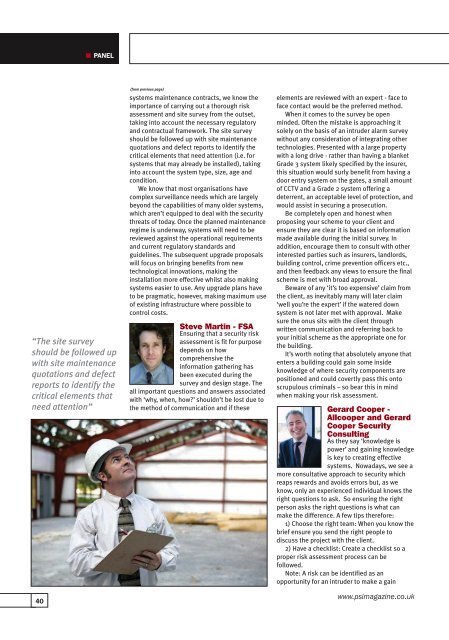PSIMay2017
You also want an ePaper? Increase the reach of your titles
YUMPU automatically turns print PDFs into web optimized ePapers that Google loves.
PANEL<br />
“The site survey<br />
should be followed up<br />
with site maintenance<br />
quotations and defect<br />
reports to identify the<br />
critical elements that<br />
need attention”<br />
40<br />
(from previous page)<br />
systems maintenance contracts, we know the<br />
importance of carrying out a thorough risk<br />
assessment and site survey from the outset,<br />
taking into account the necessary regulatory<br />
and contractual framework. The site survey<br />
should be followed up with site maintenance<br />
quotations and defect reports to identify the<br />
critical elements that need attention (i.e. for<br />
systems that may already be installed), taking<br />
into account the system type, size, age and<br />
condition.<br />
We know that most organisations have<br />
complex surveillance needs which are largely<br />
beyond the capabilities of many older systems,<br />
which aren’t equipped to deal with the security<br />
threats of today. Once the planned maintenance<br />
regime is underway, systems will need to be<br />
reviewed against the operational requirements<br />
and current regulatory standards and<br />
guidelines. The subsequent upgrade proposals<br />
will focus on bringing benefits from new<br />
technological innovations, making the<br />
installation more effective whilst also making<br />
systems easier to use. Any upgrade plans have<br />
to be pragmatic, however, making maximum use<br />
of existing infrastructure where possible to<br />
control costs.<br />
Steve Martin - FSA<br />
Ensuring that a security risk<br />
assessment is fit for purpose<br />
depends on how<br />
comprehensive the<br />
information gathering has<br />
been executed during the<br />
survey and design stage. The<br />
all important questions and answers associated<br />
with ‘why, when, how?’ shouldn’t be lost due to<br />
the method of communication and if these<br />
elements are reviewed with an expert - face to<br />
face contact would be the preferred method.<br />
When it comes to the survey be open<br />
minded. Often the mistake is approaching it<br />
solely on the basis of an intruder alarm survey<br />
without any consideration of integrating other<br />
technologies. Presented with a large property<br />
with a long drive - rather than having a blanket<br />
Grade 3 system likely specified by the insurer,<br />
this situation would surly benefit from having a<br />
door entry system on the gates, a small amount<br />
of CCTV and a Grade 2 system offering a<br />
deterrent, an acceptable level of protection, and<br />
would assist in securing a prosecution.<br />
Be completely open and honest when<br />
proposing your scheme to your client and<br />
ensure they are clear it is based on information<br />
made available during the initial survey. In<br />
addition, encourage them to consult with other<br />
interested parties such as insurers, landlords,<br />
building control, crime prevention officers etc.,<br />
and then feedback any views to ensure the final<br />
scheme is met with broad approval.<br />
Beware of any ‘it’s too expensive’ claim from<br />
the client, as inevitably many will later claim<br />
‘well you’re the expert’ if the watered down<br />
system is not later met with approval. Make<br />
sure the onus sits with the client through<br />
written communication and referring back to<br />
your initial scheme as the appropriate one for<br />
the building.<br />
It’s worth noting that absolutely anyone that<br />
enters a building could gain some inside<br />
knowledge of where security components are<br />
positioned and could covertly pass this onto<br />
scrupulous criminals – so bear this in mind<br />
when making your risk assessment.<br />
Gerard Cooper -<br />
Allcooper and Gerard<br />
Cooper Security<br />
Consulting<br />
As they say ‘knowledge is<br />
power’ and gaining knowledge<br />
is key to creating effective<br />
systems. Nowadays, we see a<br />
more consultative approach to security which<br />
reaps rewards and avoids errors but, as we<br />
know, only an experienced individual knows the<br />
right questions to ask. So ensuring the right<br />
person asks the right questions is what can<br />
make the difference. A few tips therefore:<br />
1) Choose the right team: When you know the<br />
brief ensure you send the right people to<br />
discuss the project with the client.<br />
2) Have a checklist: Create a checklist so a<br />
proper risk assessment process can be<br />
followed.<br />
Note: A risk can be identified as an<br />
opportunity for an intruder to make a gain<br />
www.psimagazine.co.uk

















